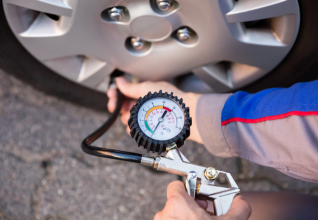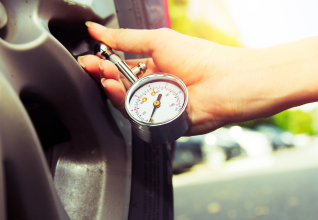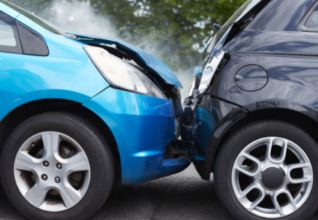Checking your car’s tyre pressure is one of the quickest and most important maintenance tasks you can do. It’s something that a lot of drivers forget or even overlook but driving on tyres set to the correct pressure is important for your safety, your car’s performance and even your fuel budget – did you know that a mere 10% drop in tyre pressure can result in a 2.5% decrease in fuel efficiency?
Tyre pressure is the air in your car’s tyres, commonly expressed in PSI, bar, or kilopascals (kPa). Knowing what this pressure is and how to read it is vital to number of factors, including safety, performance, and fuel efficiency.
So, when should tyre pressure be checked and how do you check it? Below, we’ll walk you through why it matters, how to find the right pressure for your car and give a simple step-by-step process for checking and adjusting it.
Why Correct Tyre Pressure Is Important
How Tyre Pressure Affects Safety
Your safety on the road is directly linked to your tyres and the condition of your tyres. When properly inflated to the manufacturer’s recommended pressure, the maximum amount of tread (known as the “contact patch”) is pressed firmly against the road surface.
This helps give your tyres the best possible grip on the road, which affects your vehicle’s handling and its ability to brake.
On the other hand, if the tyre pressure is too high or too low, it may affect the tyre’s grip on the road, increasing the time it takes to stop, making it harder to turn and, in extreme situations, may lead to blowouts or unexpected tyre failure. An over-inflated tyre is also more prone to damage caused by driving over potholes or other debris in the road.

How Tyre Pressure Affects Performance
The performance of your car is significantly impacted by tyre pressure and safety. But performance isn’t just about speed, it also translates to how it feels to drive and how well it responds to your inputs.
Correct tyre pressure is important for predictable handling and smooth driving. No matter the road conditions, a car with properly inflated tyres will be responsive, handle well and provide a smooth and comfortable journey for you and your passengers.
On the other hand, improper tyre pressure can result in uneven wear, a harsh ride and early replacement. Under-inflated tyres tend to wear down unevenly on the outer edges, while an over-inflated tyre will wear down prematurely in the centre of the tread.
In both cases, you will need to replace your tyres sooner than expected.
How Tyre Pressure Affects Fuel Economy
You might be surprised to learn that your tyre pressure can impact your car’s fuel efficiency. Your vehicle’s rolling resistance rises as a result of underinflated tyres.
An under-inflated tyre has a higher “rolling resistance,” which means it creates more friction with the road. This forces your car’s engine to work harder and burn more fuel just to keep moving at the same pace.
The Road Safety Authority (RSA) consistently highlights correct tyre pressure as a key way to improve fuel efficiency. By regularly checking your tyres and keeping them inflated to the correct pressure, you can make sure your car is as fuel-efficient as possible, saving you money every time you visit the petrol pump.
When you check your car’s recommended tyre pressure or look at a gauge at a petrol station, you might encounter two different units of measurement: pounds per square inch (PSI) and Bar. Other units other kilopascals (kPa) are also used, especially in different parts of the world.
Understanding Tyre Pressure Units: PSI vs Bar
When monitoring the pressure in your tyres, it’s important you know the difference between these units. You should also where to check the recommended tyre pressure for your specific car, which is usually found in the owner’s manual or on a sticker attached to the driver’s side door jamb or fuel filler cap.
- PSI (Pounds per Square Inch) is the imperial measurement and is the standard unit used for tyre pressure in Ireland, the UK and the United States. The pressure figure displayed on the sticker inside your car’s door jamb will almost always be in PSI. This is the number you should focus on.
- Bar is the metric unit of pressure, widely used in mainland Europe. Because cars and tyre equipment are made for global use, most pressure gauges, especially those on air compressors at petrol stations, will show both PSI and Bar. Typically, you will see two rings of numbers on the gauge, one will be PSI and the other Bar.
The most important thing to know is the conversion: one Bar is equal to approximately 14.5 PSI.
There is a big difference between the two pressures, and it’s why you need to make sure you’re reading correct scale. For example, if your car’s recommended pressure is 32 PSI and you mistakenly inflate it to 32 Bar, you would be putting in almost 465 PSI. This is an extremely dangerous level of pressure that would likely cause the tyre to rupture or explode.
Before you start inflating, always take a moment to identify the PSI scale on the pressure gauge. If you’re ever unsure, check out our handy PSI Converter to help you find the correct reading:
When Should Tyre Pressure Be Checked?
Regular Routine Checks
One of the most common questions motorists ask is, “When should I check my tyre pressure?” Generally speaking, you should check your tyre pressure at least once each month. Your tyres may still have a gradual leak even if they appear to be in good condition. Regular inspections assist in identifying these slow leaks, allowing you to remedy them before they worsen.
Seasonal Changes
Chnages in temperature can impact the pressure in your tyres. Generally speaking, tyre pressure will change by around 1 PSI for every 10 degrees that the temperature changes. Due to this variation, your tyre pressure checks should alter with the seasons. When changing from summer to winter, and vice versa, it is crucial to check your tyre pressure.
Long Trips
It’s essential to check your tyre pressure before starting a long journey. Your tyres may heat up and lose pressure while you drive for a long time. Additionally, travelling with extra weight, like passengers or a boot full of luggage, can put more stress on your tyres and increase the likelihood of a blowout.
Before a long trip, check your tyre pressure to make sure your tyres are ready to take the added weight and extended driving.
After Tyre Repair or Replacement
If you have had a tyre repaired or replaced, check the tyre pressure. It’s crucial to adjust a new or patched tyre to the same pressure as the rest of your tyres because they might not have been inflated to the proper level. This constancy will provide even tyre wear and balanced handling.
How to Check Tyre Pressure

You should check your tyre pressure at least once a month and always before a long journey.
- Use a Reliable Gauge: You will need a tyre pressure gauge. You can buy a simple digital or dial gauge, or use the one attached to the air compressor at a local petrol station. Some newer vehicles also come equipped with built-in tyre pressure monitoring systems (TPMS), alerting you when your tyre pressure is low.
-
Check When Tyres are “Cold”: For an accurate reading, always check your tyre pressure in the morning before you have driven for the day, or at least a few hours after a long drive. Driving heats up the air in your tyres, which increases the pressure and gives a false reading.
-
Unscrew the Valve Cap: Remove the small plastic cap from the tyre’s valve stem. Keep it somewhere safe so you don’t lose it.
-
Take the Reading: Press the gauge firmly onto the valve stem. You will hear a brief hiss of air, and the gauge will then show the reading in PSI or Bar. Compare this reading to the manufacturer’s recommendation.
-
Adjust the Pressure: If the pressure is too low, use an air compressor to add air in short bursts, checking the pressure with your gauge after each one. If the pressure is too high, most gauges have a small nub you can use to press down on the pin in the centre of the valve stem to release air.
-
Replace the Valve Cap: Once the pressure is correct, screw the valve cap back on securely. Repeat the process for the other three tyres, and don’t forget the spare wheel if you have one.
How To Adjust Tyre Pressure
Following the manufacturer’s recommendations for your specific vehicle, you must change your tyre pressure if it is too high or too low. Release some air if it’s too high, and check again. If it’s too low, use a tyre inflator to add air until you get the right pressure. Once finished, don’t forget to replace the valve cap securely.
Tyre Pressure Check Takeaways
The right tyre pressure should always be maintained, even though it may seem simple and insignificant. Understanding when and how to check your tyres’ pressure can enhance your vehicle’s performance, security, and fuel efficiency. Make sure to incorporate it into your routine auto maintenance schedule to benefit your tyres, wallet, and the environment.
Guide to Tyre Pressure
Frequently Asked Questions
Looking to Save On Your Car Insurance?
At KennCo, our car insurance cover offers competitive rates and valuable benefits, including a replacement car as standard. Get peace of mind knowing you’re fully covered.
Get a Secure Quote Today
